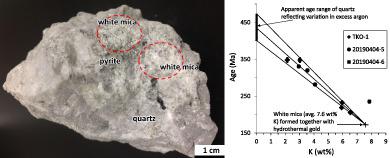当前位置:
X-MOL 学术
›
Resour. Geol.
›
论文详情
Our official English website, www.x-mol.net, welcomes your feedback! (Note: you will need to create a separate account there.)
K–Ar geochronology of orogenic gold mineralization in the Vangtat gold belt, southeastern Laos: Effect of excess argon in hydrothermal quartz
Resource Geology ( IF 1.4 ) Pub Date : 2021-02-09 , DOI: 10.1111/rge.12258 Patthana Bounliyong 1 , Tetsumaru Itaya 2 , Antonio Arribas 1, 3 , Yasushi Watanabe 1 , Henry Wong 4 , Takuya Echigo 1
Resource Geology ( IF 1.4 ) Pub Date : 2021-02-09 , DOI: 10.1111/rge.12258 Patthana Bounliyong 1 , Tetsumaru Itaya 2 , Antonio Arribas 1, 3 , Yasushi Watanabe 1 , Henry Wong 4 , Takuya Echigo 1
Affiliation

|
The Thongkai‐Ok gold deposit is one of several actively mined deposits in a newly discovered orogenic gold belt in southeastern Laos. At a district scale, gold mineralization occurs within the Vangtat shear zone, one of the tectonic structures of the Poko suture zone that marks the collision between the Indochina Terrane and the Kontum Massif in southern Laos‐central Vietnam. High grade gold mineralization is associated with quartz–pyrite–white mica veins and silicified zones up to 10 m thick, hosted by strongly deformed and sheared pelitic schist. Lower‐grade gold mineralization occurs in a graphite–carbonate–quartz–sulfide hydrothermal alteration envelope that grades into sub‐economic/barren altered pelitic schist. The objective of this study is to establish the age of mineralization in the Vangtat orogenic gold belt by K–Ar dating of hydrothermal white mica in the gold‐bearing quartz‐sulfide veins in order to better understand its spatial and temporal relation to other gold deposits in Southeast Asia and to regional tectonic events. Three‐white mica bearing quartz–pyrite samples were collected from the open pit at Thongkai‐Ok. The dominant white mica phase in the samples is 2M1 muscovite and the K2O content measured by electron microprobe techniques in individual white mica crystals ranged between 8.61 and 9.79 wt%. Two of the three vein samples were separated by gravity settling into four size fractions, <2, 2–4, 4–10, and 10–40 μm, respectively. The results of potassium measurements by flame photometry in the K–Ar sample aliquots show a range in potassium content which reflects the amount of quartz present in each sample as an impurity. With one exception, a correlation was observed between potassium concentration in the samples, including the size fraction separates, and the calculated K–Ar age. The large range of calculated ages, from 348 to 206 Ma, is interpreted to reflect excess argon contained in fluid inclusions in the hydrothermal quartz present in the analyzed samples. We interpret the youngest age of the quartz‐free samples, 206 ± 4 Ma, as closest to the age of mineralization in the Vangtat gold belt. The age could be as young as ~170 Ma if the age versus potassium content relation is extrapolated to the average potassium content of white mica in the samples analyzed.
中文翻译:

老挝东南部Vangtat金带中造山金矿化的K–Ar地质年代学:热液石英中过量氩的影响
Thongkai-Ok金矿床是老挝东南部新发现的造山带中几个活跃开采的矿床之一。在一个地区范围内,金矿化发生在Vangtat剪切带内,该剪切带是Poko缝合带的一种构造构造,标志着印度支那Terrane和越南南部老挝中部的Kontum地块之间的碰撞。高品位的金矿化与石英—黄铁矿—白云母脉和高达10 m厚的硅化带有关,主要由强烈变形和剪切的胶质片岩构成。低品位的金矿化发生在石墨-碳酸盐-石英-硫化物的热液蚀变包层中,其等级为次经济/贫瘠蚀变的胶质片岩。这项研究的目的是通过含金的石英-硫化物脉中的热液白云母的K-Ar定年,确定Vantgat造山带中的矿化年龄,以便更好地了解其与其他金矿的时空关系。在东南亚和区域性构造事件中。从通凯奥克的露天矿中收集了三颗含白云母的石英黄铁矿样品。样品中主要的白云母相为2M1白云母和K 2通过电子探针技术测得的单个白云母晶体中的O含量范围为8.61至9.79重量%。通过重力沉降将三个静脉样本中的两个分为四个大小部分,分别为<2、2-4、4-10和10-40μm。等分试样在火焰光度法中通过火焰光度法测量钾的结果表明,钾含量的范围反映了每个样品中作为杂质存在的石英的数量。除了一个例外,观察到样品中钾的浓度(包括分离的大小部分)与计算出的K–Ar年龄之间存在相关性。计算的年龄范围很大,从348Ma到206Ma,被解释为反映了分析样品中存在的热液石英中流体包裹体中所含的过量氩。我们解释了无石英样品的最年轻年龄,206±4 Ma,最接近Vangtat金矿带的成矿时代。如果将年龄与钾含量的关系推断为分析样品中白云母的平均钾含量,则年龄可低至约170 Ma。
更新日期:2021-03-04
中文翻译:

老挝东南部Vangtat金带中造山金矿化的K–Ar地质年代学:热液石英中过量氩的影响
Thongkai-Ok金矿床是老挝东南部新发现的造山带中几个活跃开采的矿床之一。在一个地区范围内,金矿化发生在Vangtat剪切带内,该剪切带是Poko缝合带的一种构造构造,标志着印度支那Terrane和越南南部老挝中部的Kontum地块之间的碰撞。高品位的金矿化与石英—黄铁矿—白云母脉和高达10 m厚的硅化带有关,主要由强烈变形和剪切的胶质片岩构成。低品位的金矿化发生在石墨-碳酸盐-石英-硫化物的热液蚀变包层中,其等级为次经济/贫瘠蚀变的胶质片岩。这项研究的目的是通过含金的石英-硫化物脉中的热液白云母的K-Ar定年,确定Vantgat造山带中的矿化年龄,以便更好地了解其与其他金矿的时空关系。在东南亚和区域性构造事件中。从通凯奥克的露天矿中收集了三颗含白云母的石英黄铁矿样品。样品中主要的白云母相为2M1白云母和K 2通过电子探针技术测得的单个白云母晶体中的O含量范围为8.61至9.79重量%。通过重力沉降将三个静脉样本中的两个分为四个大小部分,分别为<2、2-4、4-10和10-40μm。等分试样在火焰光度法中通过火焰光度法测量钾的结果表明,钾含量的范围反映了每个样品中作为杂质存在的石英的数量。除了一个例外,观察到样品中钾的浓度(包括分离的大小部分)与计算出的K–Ar年龄之间存在相关性。计算的年龄范围很大,从348Ma到206Ma,被解释为反映了分析样品中存在的热液石英中流体包裹体中所含的过量氩。我们解释了无石英样品的最年轻年龄,206±4 Ma,最接近Vangtat金矿带的成矿时代。如果将年龄与钾含量的关系推断为分析样品中白云母的平均钾含量,则年龄可低至约170 Ma。



























 京公网安备 11010802027423号
京公网安备 11010802027423号